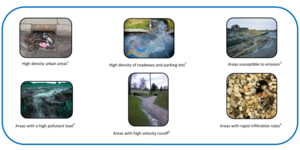
Pre-treatment considerations for stormwater infiltration
Infiltration BMPs are susceptible to clogging from the trash, debris, and suspended sediments present in runoff. Pretreatment can remove debris and coarser sediments in an easier-to-maintain pre-treatment device that will extend the life and reduce maintenance for the infiltration BMP. If work is being done under an MPCA Permit, then it is REQUIRED that some form of pre-treatment be installed upstream of an infiltration BMP. In all other cases pretreatment is highly recommended.
Situations where pre-treatment is particularly important

Conditions when pretreatment is of particular importance (Sources: 1-Environmental Health and Safety, Western Michigan University, with permission) Storm Water; 2-Winegrad, Gerald. 2015. Chesapeake Bay Action Plan; 3-WI DNR. 2012. Soil Erosion from New Construction.4-Betts, Lynn. 1999. Runoff of Soil & Fertilizer. 5-Hoogestraat, Galen. 2013. Runoff Flowing through Arrowhead Golf Course. 6-Sepp, Siim. 2011. Rounded Fine-Grained Eolian Sand Sample from the Gobi Desert.
Pretreatment is of particular importance in the following situation
- High density urban areas. High density urban areas are more likely to contain high concentrations of trash, sediments, and pollutants which can be carried by the stormwater runoff. High density urban areas contain a higher concentration of roadways; of particular concern with roadways are trash, debris and sediments (making pre-treatment an important part of the BMP) as well as metals and chlorides.
- Areas with high potential for erosion. Areas that are susceptible to erosion are of concern because of high sediment loads that reduce the BMP’s infiltration capacity. This will clog the infiltration BMP.
- Areas where stormwater has a high pollutant load. Areas with a high pollutant load, or the presence of certain pollutants that are not easily removed from runoff are a concern because they have the potential to contaminate the groundwater.
- Storm sewers that convey runoff at a high velocity. A high velocity will keep sediment in suspension. Pretreatment should be installed to facilitate the proper settling of the sediment, which will prevent clogging. In addition, high velocities can reduce the volume of runoff that can be infiltrated.